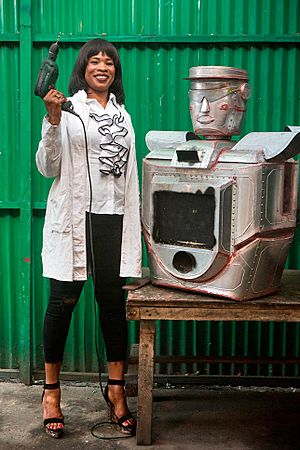Thérèse Kirongozi facts for kids
Thérèse Izay Kirongozi, born on June 3, 1973, is a talented engineer from the Democratic Republic of Congo. She is famous for creating special traffic robots. These robots help control traffic in busy cities. They were first placed in Kinshasa in 2013. By 2015, five robots were working in Kinshasa and one in Lubumbashi. Using robots as traffic lights is quite unique to her country.
Contents
Early Life and Inspiration
Thérèse was born in Kinshasa, Zaire (now the Democratic Republic of Congo) on June 3, 1973. She studied engineering in her hometown. From a young age, Thérèse cared deeply about road safety. This interest grew after her brother was hurt by a vehicle.
The idea for traffic robots came to Thérèse and her friends in college. She saw how easily people would speed or ignore traffic rules. Drivers often tried to bribe their way out of trouble. Thérèse wanted a reliable and fair way to manage traffic. She believed robots could make sure everyone followed the rules. This could also help the city earn money for new roads.
Meet the Traffic Robots
Thérèse has designed amazing humanoid robots that manage traffic. She proudly says, "There are many robots in the world. But a robot that controls road traffic and keeps people safe? That's truly made in Congo!"
Thérèse is an industrial engineer in electronics. She also leads Women's Technology (Wotech). This group builds these special robots. The latest robots are named Tamuke, Mwaluke, and Kisanga. Police bought these robots in March 2015. Now, at least five of them are helping with traffic in Kinshasa.
How the Robots Work
The new robots have cameras in their "eyes" and "shoulders." These cameras constantly film the traffic. An antenna on their head sends this information to a control center. This happens using an Internet Protocol (IP) connection.
The first robots were made in 2013. They cost about $15,000 each. The newer robots, launched in 2015, cost about $27,500 each. Each robot weighs about 250 kilograms (550 pounds). They stand 2.5 meters (8.2 feet) tall. They are made of aluminum to handle the hot, wet climate.
A solar panel on the robot's head provides power. This is very helpful in a city where electricity can be unreliable. These robots can turn their chest and raise their arms. They act just like a human traffic officer. They stop cars in one direction and let others go. Some robots can even spot people walking. They are programmed to "speak" and tell people when it's safe to cross. When people wait, a robot might even sing a song about road safety rules!
People's Reaction and Expansion
People in Kinshasa have really welcomed the robots. One writer, Sam Sturgis, noted how much the robots improved traffic. Brian Sokol, a photographer, observed, "People on the streets seem to respect the robots. They don't always follow human traffic police."
A taxi driver told reporters, "Some drivers don't respect the police. But with the robot, it will be different. We should respect the robot. We are very happy about it!"
After two test robots in 2013, three new ones came to Kinshasa in March. Five more went to authorities in Katanga, including three in Lubumbashi. Val Manga, head of the National Road Safety Commission, said, "This is a good thing for road safety. We need more of these smart robots."
The company keeps improving its technology. "The robot sends real-time images to the police," says Thérèse. "We use radio waves now, but we will switch to fiber optics. Image sending will be much faster."
An "intelligent" traffic robot was also set up in Lubumbashi. People there seem excited about it. It replaces human police and has cameras to catch traffic violations. Other cities in Congo want these robots too. Women's Technology also plans to export them. Angola, Congo, Ivory Coast, and Nigeria are interested. Thérèse dreams big. She hopes to see her "Made in Congo" robots even in New York!
Images for kids



